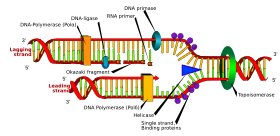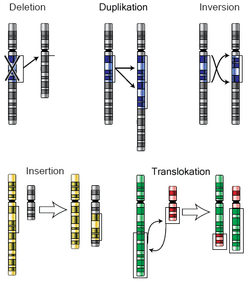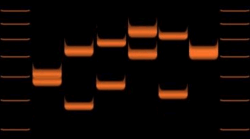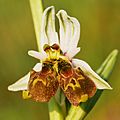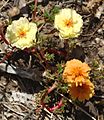Mutation facts for kids
In biology, a mutation is a change in the genetic material. This means changes to the DNA or to the chromosomes which carry the DNA. These changes are heritable (can be passed on to the next generation) unless they have lethal effects.
Mutations can happen for several reasons. It can happen because of errors when meiosis produces the gametes (eggs & sperms). Damage by radiation, or by certain chemicals may cause mutations. Mutations occur at random.
Also, by derivation, an individual carrying the mutation may be called a mutant or a mutation. So is the trait (character) most obviously affected by the mutation.
Contents
Types of mutation
DNA mutations
When DNA is copied mistakes are sometimes made – these are called mutations. There are four main types of mutations:
- Deletion, where one or more DNA bases are left out.
- Insertion, where one or more extra base is put in.
- Substitution, where one or more bases are changed for another base in the sequence.
- Duplication, where whole genes are copied.
Chromosome mutations
These terms are explained in the third diagram.
- Deletion: a piece of chromosome is lost, together with any genes which may be on it.
- Duplication: part of a chromosome is repeated
- Inversion: part of a chromosome is reversed end to end
- Insertion: a smaller chromosome is added into a longer chromosome
- Translocation: part of a chromosome gets moved onto another chromosome
Results of mutation
Mutations may be bad for the organism, or neutral, or benefit the organism. Sometimes mutations are fatal for the organism – the protein made by the 'new' DNA does not work at all, and causing the embryo to die. On the other hand, evolution is moved forward by mutations, when the new version of the protein works better for the organism.
Mutations are the ultimate source of variation, upon which natural selection acts. What happens is that some mutations affect the organism's ability to live and reproduce. This is an important part of the theory of evolution. The amount of heritable variation carried by a population can be huge, and as a result natural populations can change and adapt to conditions in their environment.
Related pages
Images for kids
-
A red tulip exhibiting a partially yellow petal due to a mutation in its genes
-
Prodryas persephone, a Late Eocene butterfly
-
The distribution of fitness effects (DFE) of mutations in vesicular stomatitis virus. In this experiment, random mutations were introduced into the virus by site-directed mutagenesis, and the fitness of each mutant was compared with the ancestral type. A fitness of zero, less than one, one, more than one, respectively, indicates that mutations are lethal, deleterious, neutral, and advantageous.
-
A mutation has caused this moss rose plant to produce flowers of different colors. This is a somatic mutation that may also be passed on in the germline.
-
Dutch botanist Hugo de Vries making a painting of an evening primrose, the plant which had apparently produced new forms by large mutations in his experiments, by Thérèse Schwartze, 1918
See also
 In Spanish: Mutación para niños
In Spanish: Mutación para niños


